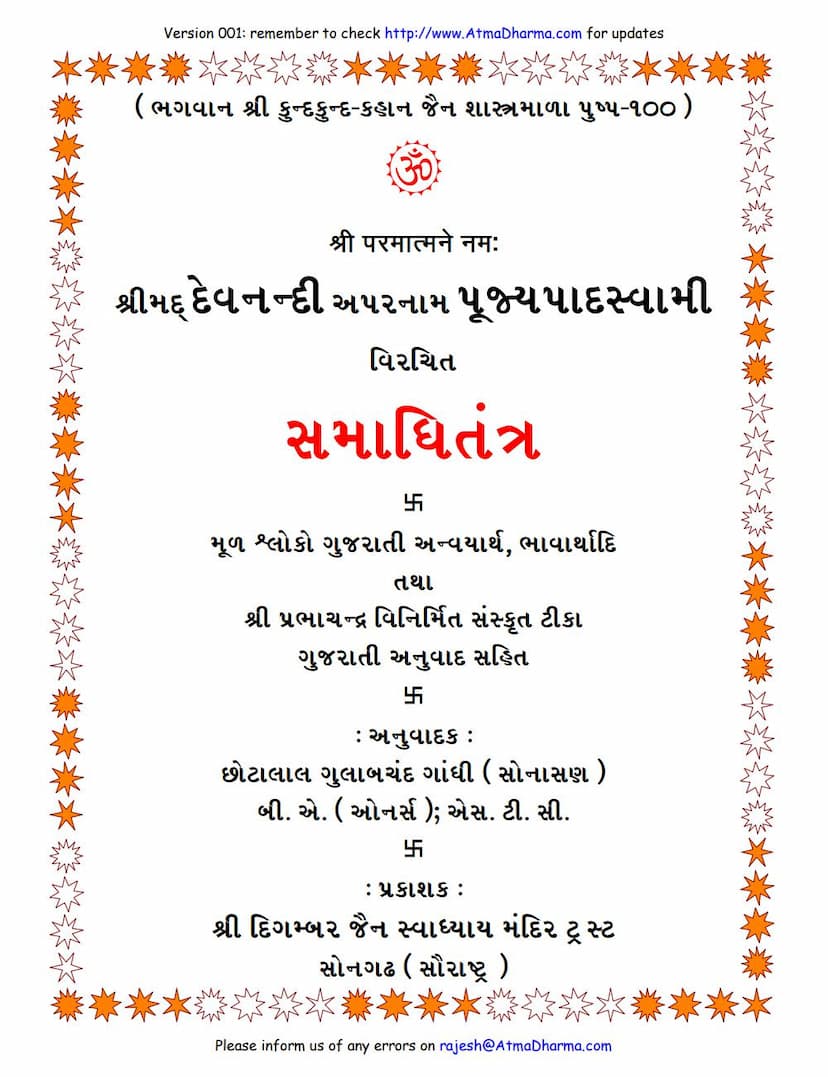Samadhi Tantra
Added to library: September 2, 2025

Summary
Here's a comprehensive summary of the Jain text "Samadhi Tantra" by Devnandi Maharaj, based on the provided pages:
Overall Purpose and Context:
- Title: Samadhi Tantra (also known as Samadhi Shatak).
- Author: Acharya Pujyapada (Devnandi Maharaj).
- Publisher: Shri Digambar Jain Swadhyay Mandir Trust, Songadh.
- Core Message: The text, with a Sanskrit commentary by Acharya Prabhachandra, focuses on guiding individuals towards liberation (Moksha) by helping them shed the identification with the body and external objects and realize the true nature of the soul. It emphasizes the importance of discrimination (Bhed Gyan) between the soul and non-soul entities.
- Spiritual Lineage: The text is presented within the context of the teachings of Pujya Shri Kanji Swami, a significant spiritual figure for the publisher and their followers.
Key Concepts and Teachings:
-
Three States of the Soul: The text elaborates on the three states of the soul:
- Bahiratma (Outer-Soul): One who mistakenly identifies with the body, senses, and external objects.
- Antaratma (Inner-Soul): One who has realized the soul as distinct from the body and senses and is on the path to liberation.
- Paramatma (Supreme-Soul): The liberated soul, fully realized and free from all worldly attachments and karmas.
-
The Path to Paramatma: The primary focus is on the path to achieving the state of Paramatma. This is achieved through:
- Bhed Gyan (Discrimination): The crucial understanding of the difference between the soul (Atma) and non-soul (Anatma) entities like the body, senses, mind, and external objects. This is highlighted as the foundation for becoming an Antaratma.
- Renunciation of External Attachments: The text stresses the need to detach from external objects and sensory experiences, as these are seen as the root cause of worldly suffering (Samsara).
- Internal Focus and Self-Realization: The path involves turning inwards, understanding the true nature of the soul, and cultivating devotion and meditation towards it.
-
The Nature of the Soul:
- Eternal and Unchanging: The soul is described as eternal, unchanging, and beyond the limitations of the body.
- Consciousness and Bliss: The soul's true nature is characterized by infinite knowledge (Keval Gyan), infinite perception (Keval Darshan), infinite power (Anant Virya), and infinite bliss (Anant Sukh).
- Beyond Dualities: The liberated soul is beyond birth and death, gender, number, and all other worldly dualities. It is described as pure, formless, and self-illuminating.
-
The Path of Yoga and Samadhi:
- Control of Senses and Mind: The text advocates for controlling the senses and the mind, turning them inwards towards the soul.
- Meditation: Samadhi, or deep meditation, is presented as a key practice to realize the self and achieve liberation. This involves holding the mind steady on the soul.
- Renunciation of Thought-Constructs: The text emphasizes transcending all mental thought-constructs (Vikalpa), including those related to speech and action, to achieve the state of formless, undisturbed consciousness.
-
The Role of the Guru: While self-effort is paramount, the teachings of a realized soul (Guru) are acknowledged as a guiding light in understanding the path. However, the ultimate realization and liberation come from within.
-
Critique of External Practices: The text subtly critiques reliance on external practices like austerities (Tapas), vows (Vrat), or external symbols (linga, jati) without the internal realization of Bhed Gyan. True liberation comes from inner transformation, not mere external observance.
-
The Illusory Nature of the World: The material world, including the body, relationships, and possessions, is described as transient and ultimately incapable of providing lasting happiness. Identifying with these external elements leads to suffering.
-
The Goal: The ultimate goal is to realize the true, pure, and blissful nature of the soul, thereby achieving Moksha – liberation from the cycle of birth and death. This state is characterized by eternal peace, infinite knowledge, and infinite bliss.
Structure and Commentary:
- The text is structured as verses (Shlokas) composed by Acharya Pujyapada.
- Each verse is accompanied by a Sanskrit commentary (Tika) by Acharya Prabhachandra, which explains the philosophical and practical implications of the original verse.
- The Gujarati translation and interpretation (Anvayarth and Bhavarth) provide further clarity for the readers.
Key Figures:
- Acharya Pujyapada (Devnandi): The primary author, a highly respected Jain Acharya known for his scholarship and spiritual insight. He is credited with composing this text.
- Acharya Prabhachandra: The commentator whose Tika provides deep explanations of the verses.
- Pujya Shri Kanji Swami: A contemporary spiritual leader whose teachings are influential in the publication and dissemination of this text.
Overall Significance:
"Samadhi Tantra" is a profound spiritual treatise that delves into the core principles of Jain philosophy, particularly focusing on self-realization and the path to liberation. It offers practical guidance through its emphasis on discrimination, detachment, and internal contemplation, aiming to lead the sincere aspirant to the state of equanimity and ultimate freedom.